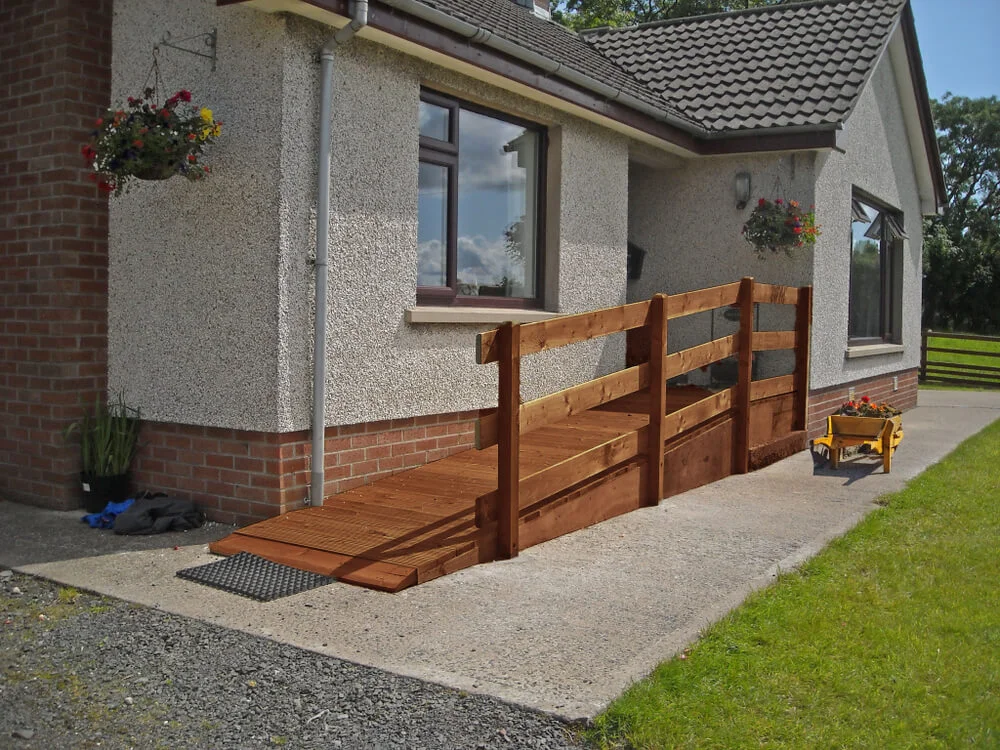Wheelchair Ramps for Homes: Design and Plans for Greater Accessibility
Wheelchair ramps for homes are often installed when elderly parents need to move in with their children, a family member suffers an injury or health condition, or disabled friends come to visit. Whatever the reason, installing a wheelchair ramp must be done safely and correctly.
Regardless of whether you’re planning on taking a DIY approach to your ramp or you’ve already started Googling “wheelchair ramp installation near me,” this article will give you some insight into what goes into selecting and installing a wheelchair ramp that meets your unique needs.
Understanding the Need for Wheelchair Ramps
Some home ramps for elderly family members are installed as a permanent way to access the home more easily.r Other ramps are installed to provide temporary access for someone who is rehabilitating an injury. How you intend to use the ramp, as permanent or temporary access, will determine the material and installation method you use.
Choosing the Right Material and Design
Wheelchair ramps for homes come in a variety of designs and materials. Before choosing the design and material, consider these factors:
- Is the ramp going to be a permanent addition to your home?
- Do you have the time and resources to perform regular maintenance?
- Do you want a ramp that blends into the design of your home?
Answering these questions will help you choose the right material and method of construction. Some of the most popular disabled ramp materials include concrete, wood, steel, and aluminum. Let’s review these different options.
Concrete ramp: This is one of the most permanent options, which also requires the least amount of maintenance. A concrete ramp can also be designed to fit the aesthetic of most homes. However, depending on the length and width required, concrete ramps for homes are often one of the more expensive options due to material and labor costs.
Wood ramp: A wood ramp usually costs less to build, but the regular maintenance required to ensure the ramp does not rot, warp, or splinter can offset the initial savings. In addition, the ramp will need to be constructed using wood that has been pressure-treated to withstand adverse weather conditions. However, even pressure-treated lumber required maintenance to keep it in good condition.
Steel ramp: While a steel ramp will be durable, it also requires maintenance to prevent rust and corrosion. Steel ramps also don’t integrate as well with many home exteriors.
Aluminum ramp: An aluminum ramp is lightweight and
Regardless of the material you choose for your ramp, you’ll also need to install anti-slip features to ensure anyone using the ramp can do so in all types of weather. These types of add-ons will increase the total cost of installation and upkeep of your ramp.
Integrating a Ramp to Your Home’s Exterior
Another thing to consider before adding a ramp to your home is how will it look on the exterior of your home? Choosing one that complements your home can get a little tricky. This is where professional expertise and experience can play an important role. An experienced local handyman will choose the right material based on your needs and has the expertise to construct and install a ramp that fits well with the exterior of your home.
DIY vs. Professional Installation
Regardless of whether the structure is temporary or permanent, following construction guidelines and acquiring the necessary permits is essential to ensure the safety of all those who will use the ramp to enter and exit your home. You’ll also need some construction skills and the right tools and equipment to successfully complete the job.
Installing a permanent concrete or steel ramp will require specialized tools and equipment that most homeowners don’t have. Construction of these types of ramps also requires a level of expertise that is outside the scope of most DIY projects. However, the installation of some temporary wheelchair ramps for homes that are made from wood material can be done as a DIY project, provided you have the necessary skills, tools, and permits to complete the job properly. To make sure that your home access ramp is installed safely and according to local building codes, find your local handyman. Professional installers will know exactly how to help you design the right type of ramp and pick the correct materials to meet all of your functional and cosmetic needs.
Meeting Safety Standards
While ADA guidelines for wheelchair ramps do not apply to private residences, they are an excellent starting point for designing and building your structure. In general, these guidelines call for:
- 1:16 to 1:20 slope ratio
- Minimum 36-inch ramp width
- Minimum top and bottom landing width that matches or exceeds minimum ramp width
- Minimum 60-inch top and bottom landing length
- Handrails on each side for ramps with a 6-inch or greater rise and/or a 72-inch or greater horizontal projection
For the complete ADA guidelines, including requirements for edge protection, visit ADA.gov. You should check with your city building code and homeowners' association to ensure you meet local regulations as well.
Space Optimization with Portable Ramps
If you are short on space or only need a ramp for your home temporarily, consider installing a portable ramp! These ramps are designed to help your visitors and family members enter and exit your home safely without the need for a large and permanent structural change to the exterior of your home.
Ramp Maintenance and Longevity
Maintaining your wheelchair ramp is an important part of ensuring it stays safe for your loved ones, especially if it’s going to be a permanent structure. Here are some of our best maintenance tips to help extend the longevity of your wheelchair ramp.
- Establish a regular cleaning schedule. Sweeping and removing dirt, leaves, and any other debris is important not only to keep the ramp in good condition but also to prevent slips or falls.
- Regularly inspect your ramp for signs of damage or wear, such as uneven sections or cracks. If you find damage, be sure to have it repaired immediately.
- Make sure that the ground under your ramp remains level. If you notice any changes or shifts that affect the slope of your ramp, correct them immediately.
Following these maintenance suggestions will extend the longevity of your ramp and keep all those who use it as safe as possible.
Budget-Friendly Accessibility Solutions
Wheelchair ramps for homes don’t have to break your budget! For cost-effective accessibility solutions, reach out to your local Mr. HandymanⓇ.
Our team of professionals have over ten years of experience in the respective trades. They can help you select the right access solution for your needs and professionally install your wheelchair ramp to ensure it’s safe and reliable for years. To learn more or to get started, request service today!
 Click to call
Click to call


